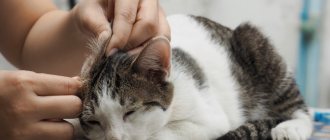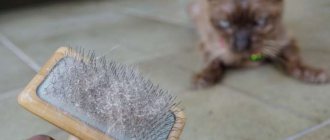10176Administration
What should you do if your cat's ears are itchy and black? Inexperienced cat owners often make the mistake of mistaking black or brown plaque in their pet's ears for earwax or dirt. Some simply make no attempt to get rid of it, others simply clean the “dirt” with a cotton swab. In fact, if a cat has black ears, then this is a clear sign of a disease called “otodecosis.” It is caused by microscopic mites. In this case, it is necessary to urgently take treatment measures.
The second name for this common disease in cats and dogs is ear scabies. An animal suffering from this disease experiences very severe discomfort and also scratches its ears until they bleed.
© shutterstock
Attention! The opinion that only street animals suffer from otodecosis is erroneous. Even the most well-groomed indoor cat can get sick. The reason for this is parasites that enter the house with the owner's shoes or clothes.
Why does plaque appear?
Lack of hygiene
Earwax in cats, like in humans, has a protective function against the entry of pathogenic fungi, bacteria and small insects into the ear canal. It also serves as a lubricant for the inner canals of the ear. The auricle itself secretes a small amount of sebum. If a lot of wax and fat accumulate in the ears, dirt and dust stick to them. Because of this, a black coating is formed, especially noticeable in breeds with large ears and open ears - American Curl, Sphynx, Rex, Havanese, Javanese, Siamese, Oriental Shorthair cats.
Ear mite
This parasite can live in various animals.
The causative agent of otodectosis is the microscopic oribatid mite Otodectes.
It parasitizes not only cats, but also dogs, rodents, and ferrets. Therefore, infection of a domestic cat is possible from other pets visiting the street. A sick cat can also infect all the pets living in the room with it. Most often it develops in animals with weak immunity and lack of hygiene. The parasite is very rare in humans and causes otitis externa.
Description of possible causes
If your cat has a black coating in one ear, it is better not to hesitate to visit the veterinarian. Often this sign is observed when tumors appear in the auricle. The earlier the formation is diagnosed, the greater the chance of a favorable prognosis. This is especially true for individuals over the age of 10 years, since their risk of developing a malignant tumor is very high. We also cannot immediately discard other possible options:
- Ear mite. Very common in cats of all breeds at any age. A pet can become infected without even leaving home. Characteristic symptoms are blackness in the ears and an unpleasant odor. Moreover, in the morning you can clean everything clean, and by lunchtime there will be a large amount of discharge again. But the most dangerous thing is the itching, which causes deep scratches in the temple area. To confirm the diagnosis, deep scrapings are taken from the auricle and examined under a microscope. Treating all animals living in the same house with Stronghold and Frontline helps against ear mites. The first is offered in the form of drops, which are applied to the pet’s withers 2 times every 3 weeks. The second one is also available in the form of drops, but they must be poured directly into the ear canal according to the instructions. To remove black discharge, you can use special lotions (8 in 1, Otifri, Hartz), which are poured inside the ear. After this, they massage the area of the temples for a couple of minutes and allow the animal to shake out all the contents. The remains are wiped off with a napkin.
- Foreign body. Getting thorns from plants, wood chips and other objects into the ear canal that can cause inflammation and suppuration almost always ends in the development of otitis media. A black discharge appears in the cat's ear, causing her to constantly shake her head. Squelching sounds while walking and an unpleasant odor from the ear canal should alert you. You'll be lucky if the splinter is within sight and reach. Then you can remove it yourself using tweezers. After extraction, the affected area is well treated with chlorhexidine. It is more difficult when the foreign body has got deep into the auricle, and without otoscopy and special grasping instruments it will not be possible to remove it. In such cases, a visit to the veterinarian is mandatory.
- Allergy. It can be a real nightmare for owners of toy breeds, who often suffer from atopic dermatitis and food allergies. Many people do not even suspect that an allergic reaction can manifest itself not only in the form of redness and peeling of the skin. Black ears, foul discharge and a foul odor may also indicate improperly selected food or recent contact with a potential allergen. Here, only eliminating the allergenic product from the diet will help (if the cause is a food allergy) or limiting access to potentially dangerous substances (with atopic dermatitis). At risk are Maine Coons, Persians, Siamese, exotics and Sphynxes. For these breeds, allergic otitis and conjunctivitis are not uncommon.
- Otitis. An inflammatory disease occurring inside the ear canal. Provoking factors may include foreign body entry, parasite activity, food allergies, atopic dermatitis, bacterial infection and neoplasms. If a cat develops blackness in one ear, then it is necessary to exclude the possibility of the formation of polyps and malignant tumors. If discharge is present in both organs of hearing, then it should be sent for cytological and microscopic examination to exclude fungi, bacteria and parasites. In the treatment of all types of otitis, the main condition is to control or exclude the underlying disease.
- Neoplasms. Polyps are benign in nature, sarcomas and squamous cell carcinoma are malignant tumors that can grow deep into the jaw or skull. Characteristic signs include black discharge from one ear and a foul odor. Very often these manifestations are confused with otitis media of allergic or bacterial origin. And only after long-term unsuccessful treatment is an otoscopy performed, with which a neoplasm can be detected. After this, an MRI of the head is mandatory to exclude metastases if a malignant tumor is suspected. Biopsy and histology will help determine the type of tumor and stage. In most cases, surgical excision of the tumor along with the ear canal is used. And even this does not guarantee a favorable prognosis.
When to sound the alarm?
If black spots and spots in a cat's ears are caused by poor hygiene, the animal remains calm and playful, and has a good appetite. The ear itself is white, not inflamed. Anxiety is caused by brown discharge, which is a waste product of the tick. Dangerous symptoms at different stages are shown in the table:
| Stage | Symptoms |
| Initial | The mite penetrates under the skin, irritating the nerve endings |
| The ear is very itchy and painful | |
| Redness and swelling of the external auditory canal | |
| Brown plaque in the ears that resembles asphalt | |
| Unpleasant smell | |
| Average | Dark crusts form and plugs form |
| Severe itching, the cat shakes its head and screams | |
| The appearance of scratches and wounds | |
| The auricle is lowered, the animal’s head is leaning towards the side of the affected ear | |
| Anxiety, aggression, poor sleep and appetite | |
| The mite spreads to the natural bald patches near the ear and muzzle, causing it to swell | |
| Perforation of the eardrum and introduction of mites into the inner ear | |
| Heavy | Dark plaque is visible not only inside the organ, but also on the tips of the ears |
| Parasites invade the brain, causing inflammation | |
| Sick animals meow loudly in pain | |
| Refusal to eat, apathy, seizures | |
| Possible death |
How to determine if it is a tick
The danger of becoming infected with ear mites exists even when the animal does not leave the house. A person can bring infection into the house along with shoes or clothing. The arthropod penetrates the cat's ear, settles there and reproduces.
An infected cat immediately changes in behavior: it becomes apathetic, it loses interest in toys and things, and the animal is indifferent even to its favorite treats. In return, the owner may get an aggressive and timid pet that does not make contact with humans and avoids touching, especially the ears.
Particular attention should be paid to the nature of the plaque. The discharge is dark brown in color, difficult to remove, and the substance itself smells unpleasant. In addition, traces of pus or blood may appear.
If there is a tick, the cat becomes restless and tries to scratch its ears all the time. Sometimes he may sit with his head slightly tilted to the side.
When the disease becomes advanced, black crusts begin to fall out of the cat’s ears, and treatment of the chronic form becomes labor-intensive and the most expensive. If you notice the first signs of ear mites, you should immediately contact a veterinarian.
What is black plaque in the ears? These photos will help you figure it out:
The doctor will scrape the animal’s ears, conduct an analysis, identify the source of the disease and prescribe appropriate treatment. In the initial form of infection, ear drops can be used, but the advanced form will require treatment with antibiotics and painkillers.
Also, during treatment, your pet must be given special food and vitamins to support the immune system and speed up recovery.
The incubation period for ear mites is 21 days. Therefore, if other animals live in a house with an infected cat, it is better to isolate the sick pet from contact with other inhabitants, and the room should be thoroughly disinfected.
It's worth taking ear mites in your pet seriously. If the necessary measures are taken too late or not at all, the cat may completely lose his hearing.
Diagnostic measures
The animal's hearing organs are subject to a thorough examination by a doctor.
To find out why the ear turns black, the veterinarian performs an external examination. A specific crust, scratching and greasy black discharge help in making a diagnosis. To confirm otodectosis, plaque scraping and examination under a microscope are performed. The procedure takes little time, is painless and non-traumatic. An otoscopy is also performed to find out how much the inner ear is affected.
Prevention of ear diseases and ear hygiene in cats
If your pet has had an ear infection, often walks outside, or is hypothermic, then he may get sick again. It is necessary to use preventive measures to protect it from all factors that cause black plaque inside the ear.
Basic preventive measures:
- monitor the condition of the cat’s ears and promptly clean them with a cotton swab or cleansing lotion;
- pay attention to high-quality animal feed with a vitamin complex, avoid feeding food from the table;
- give vitamin and mineral supplements to boost immunity;
- do not let your pet become ill; consult a doctor in a timely manner;
- isolate the animal from contact with stray and infectious animals;
- do preventive treatment of your pet against fleas and ticks, for example, with the drug fleanet max.
If a cat has black plaque in his ears, wipe the auricle with a cotton pad. Cotton swabs are not recommended for use, as they are harsher and can injure the cat's ear.
Wiping the ear with an antiseptic
Hydrogen peroxide, black and green tea, and salicylic alcohol are also used to wipe the ear. They treat the affected areas before applying the main product.
How to treat?
Veterinarians recommend cleaning your pet’s ears no more than 1-2 times a week, since daily hygiene procedures reduce the natural balance of beneficial microflora and make the cat vulnerable to pathogens.
If your cat’s ears have brown plaque and spots due to dirt, you should clean the outer part of the hearing organ with special hygiene products:
The hygiene of the external part of the pet's hearing organs can be maintained with the help of Otifri.
- "Leopard";
- "Otifri";
- "SkinMed Otik";
- "Tropiclean Dual";
- "Sani Pet";
- "Beafar Air Cleaner";
- "Trixie."
If your ears itch and hurt due to mites, you should treat them with anti-mite medications. The dosage for an adult cat and kitten is determined by a veterinarian; self-medication is prohibited. Both hearing organs should be instilled, even if infection occurs in only one. The procedure should be done with drugs such as “Bars”, “Otoferonol Gold”, “Amitrazine Plus”, “Surolan”. During the treatment period, all animals living in the premises, their sleeping places and accessories should be disinfected.
Rules for the use of medicines
Treatment begins with washing the ears with an antiseptic. After this, liquid medications are injected using a syringe without a needle. Ear drops are often used.
The cat has hot ears: what does this mean?
Important! Even if one ear is affected, drops should be instilled into both. After instilling the drops, the animal's ear is massaged.
In addition to drops, ear ointments, aerosols, gels, powders, and sprays are used.
Instillation of acaricidal (anti-mite) drugs into the animal’s ear
The following medications are used to treat ear mites:
- leopard;
- removed;
- tsipam;
- aurican;
- normax, etc.
Treatment of ear mites is carried out for 5-7 days, which is due to the cyclical life of the mite.
To treat otitis, antibiotics are used, which must be prescribed by a veterinarian. Usually these are drugs from the cephalosporin group.
Ear fungus is treated with drugs:
- econazole;
- clotrimazole;
- flucytosine;
- amphotericin B.
Important! During long-term treatment with drugs, hepatoprotectors should be used to reduce the load on the animal’s liver.
Treatment options
Effective medicines to combat ear mites are insecticide-based products. The only point that needs to be taken into account is that they act specifically on living parasites, but are absolutely not effective in killing larvae. Since the incubation period of infection is 21 days, the course of therapy should last at least three weeks, covering the entire life cycle of the tick.
- Drops. Most often, the following drugs are prescribed: Tresaderm, Ivomek, Bars, Amitrazine Plus, Otoferonol Gold, Tsipam. The advantage of using Tresaderm is that the antibiotic included in its composition affects not only the adult tick, but also its eggs, and at the same time fights fungi and other infectious inflammations. The drug Ivomec can be prescribed in the form of injections and injected into the animal according to a schedule several times a month. The remaining drops from the above list tend to affect worms if they are present.
Important: so that the cat does not get nervous during instillation, the liquid must be slightly warmed up.
- Ointments (aerosols). Aversectin ointment works well in practice, which is applied to the ear with a special spatula and is well absorbed into the skin during rubbing. Amit ointment, made on the basis of amitraz and prednisolone, has a similar acaricidal effect. Disinfection of the ears is carried out twice a day for 5 days. A cotton swab is lubricated with a creamy substance and then gently rubbed into the skin. Acaromectin spray, sprayed onto the inner surface of the ear according to the attached instructions, is effective against otodectosis.
A doctor may also prescribe Stronghold, Frontline or Oridermil, but these drugs are contraindicated for use as self-medication - only on the recommendation of a veterinarian. For preventive purposes, the drug Revolution for Cats is often prescribed - It is applied to the withers using a drop method. After absorption into the skin, the active substance acts simultaneously on both ticks and fleas, if any.
Prevention of ear diseases in animals
Treatment of a kitten at the veterinarian
Preventing the onset of disease is much easier than treating an infected animal. To keep your pet safe, have your pet's ears cleaned and checked by a veterinarian monthly. It is also recommended to deworm your kitten regularly. The likelihood of ear mite infestation increases if your kitten comes into contact with other animals that may be carriers. Therefore, try to avoid unwanted contacts. Also make it a habit to clean your home and pets' bedding twice a week to reduce the risk of infection.
Characteristic symptoms
One of the symptoms is itching in the ear
An animal can become infected in several ways: while walking, playing on the lawn, in the garden, etc.; from a mother cat infected with ear mites; from other animals; as a result of lack of ear hygiene.
Ear mite infestation is a very common problem in kittens, although animals of any age are susceptible to this disease. Signs of infection can have varying degrees of severity and appear comprehensively or partially. In addition to the fact that a cat has dark plaque in its ear, the following symptoms of the disease can be detected:
- Scratching and constant head shaking caused by irritation.
- Discharge of a waxy dark substance from the ears.
- Hair loss due to herbs caused by scratching.
- Presence of a rash in the ear.
- The presence of a hematoma in the ear (its appearance causes rupture of small blood vessels between the skin and cartilage as a result of scratches).
Skin lesions most often affect the ear and surrounding areas, but other parts of the body can sometimes be affected.
There is a black coating in the cat's ears. How can I help at home?
First of all, at home, you can try to gently clean your ears.
- Pour lotion into both ears ( Epiotic , Otifri, Rosinka, Klini). The drug should be at room temperature or slightly warm.
- Massage the ears at the base.
- Allow the cat to shake its head to remove excess lotion.
- Use special wet wipes for cleaning ears or a regular cotton pad to remove discharge. You cannot go deep into the external auditory canal. The use of cotton swabs is contraindicated, as they can injure an already inflamed ear and push secretions towards the eardrum.
Secondly, if your cat scratches its ears, you need to put a protective collar on it. Otherwise, pyotraumatic dermatitis and otohematoma may occur.
Thirdly, it would not be a bad idea to treat the cat and all other animals in the house against ectoparasites, including ear mites. Drugs that can be used: Stronghold, Helmintal, Lawyer, Inspector.
But it is still recommended to consult a doctor to find out the exact cause. It is important to note that you do not need to clean your ears before visiting a doctor! This will blur the picture, and the opportunity to make an adequate diagnosis may be lost.
Recommendations from a specialist. Click on the picture to open in full size
Black plaque in the ears of cats: Causes
The appearance of black plaque in the ears can be due to several reasons:
- Dirt . Dust stuck to earwax can cause black discharge. This is most often noticeable in stray cats.
- Otodectosis . Ticks of the species Otodectes cynotis produce secretions during their life. As a rule, they are black or dark brown, dry, and flakes. Any cat can become infected; it doesn’t have to go outside to do so, since you go outside there.
- Bacterial otitis.
- Fungal otitis media . The yeast-like Malassezia produces a dark, ointment-like discharge.
- Biofilm . In the case of chronic, “healed” otitis media, resistant bacteria can secrete substances that form a biofilm—a dark, oil-like discharge that is difficult to remove.
- Gore . In case of injury or exposed tumors, it may turn black.
Like what you're reading? Check out other articles about cat health: Alarm Clock Cat. How to wean your pet from the habit of waking up? — Do I need to wash cats and if so, how? Tips for bathing tailed cats - https://strazhchistoty.ru/cleanup/cleancats/nado-li-myt-koshek.html How to learn to understand your cat? — https://strazhchistoty.ru/cleanup/cleancats/kak-ponimat-koshku.html
Black ears in cats: Diagnosis
To diagnose black discharge from the ears, use:
- Otoscopy. To assess the condition of the external auditory canal and eardrum. Imaging is possible if there is no excessive discharge or swelling.
- Scraping for the presence of ectoparasites. It is performed quite quickly, right at the reception.
- Cytological examination of an ear smear. The colored preparation gives an idea of the presence, quantity, and shape of microorganisms.
- Bacteriological culture with sensitivity to antibiotics. Necessary when rods are detected during cytological examination and in case of recurrent otitis.
- Video otoscopy. It is used to exclude neoplasms and foreign bodies deep in the ear. The examination is performed under general anesthesia. To prepare for this procedure, you will need to do an ultrasound of your pet's heart and donate blood.
- An X-ray with contrast may be required.
- Computed tomography if otitis media or brain damage is suspected.
Folk remedies
If for some objective reason a visit to the doctor is temporarily impossible, then traditional medicine comes to the rescue. Herbs and lotions are unlikely to be able to completely cure otodectosis, but they may well be able to alleviate the animal’s suffering until the time of visiting the veterinary clinic.
- Green tea based drops. A tablespoon of dry leaves is poured into a glass of water and left for 5-10 minutes. After cooling to a warm state, the solution is taken into a pipette and a few drops are instilled into each ear.
- Garlic has powerful antiseptic properties. In the case of ear mites, it is infused in oil for 24 hours, and then the resulting solution is instilled into the ears once a day. Olive, flaxseed, sunflower, almond and other oils are used as the basis for the tincture.
- Celandine juice is instilled into the ears in the morning and evening, two drops per ear. Freshly picked herbs are ground in a meat grinder and then squeezed in gauze to prevent any remaining leaves or stems from getting into the juice ready for use.
And the last thing you should not forget about is to try to give the cat maximum attention and care in order not only to alleviate its suffering, but also to speed up the healing process.
Causes and diseases of cats that cause black plaque to appear
The dirt that owners find in their cat's ears is not always brown. Often its color is closer to black. The presence of a substance of this color in the ear means that the cat is most likely sick.
What exactly depends on the symptoms, but there are three main problems that almost every pet owner can face.
Otodectosis
This disease is caused by one of the most common parasites of cats - ear mites. Ear mites are arthropods that inhabit almost all ear canals and multiply rapidly.
It first settles in the outer ear. Having completely colonized it, the mite begins to colonize the medial and internal canals.
It is quite simple to determine that your cat has otodectosis - the brown plaque continues to accumulate even after its removal, which is why treatment must be started immediately.
The disease has several stages, which determine the method of treatment:
Each of them is characterized by its own symptoms:
- During the initial phase, the mass released from the shell is dry, like the surface of the ear itself. There is no scratching.
- At an advanced stage, the mass becomes more viscous, the ear becomes inflamed due to the appearance of colonies of fungi and bacteria.
Ear mite
When treating the first stage of the disease, it is enough to use Otodexin ear drops, aerosols and lotions. And the second requires the use of antibiotics and antimycotic agents.
Formation of sulfur plugs
If your cat belongs to a breed with an unusual ear structure, for example, a Sphynx, then it is highly likely that the cause of the dark plaque inside the ears is wax plug. These cats simply have increased sulfur production. It accumulates and various microorganisms develop in it.
The wax plugs themselves, although they cause discomfort for the cat, are quite harmless. But they can lead to inflammation. Therefore, avoid their occurrence simply by monthly preventative removal of excess wax from your pet’s ear.
The main way to treat wax plugs at home is by instilling a special lotion. As a result of this, it dissolves. If this still does not happen, contact your veterinarian.
The accumulation of wax may be a sign of a more serious problem - otitis media. In fact, this is the name for severe inflammation of one of the ear canals.
- External
- Medial
- Interior
With internal otitis, only a veterinarian can help your pet
Otitis externa can be determined by the fact that the cat not only has black plaque in the ears, but the ears also smell bad. She can also itch a lot in the ear area.
Medial otitis media is often a consequence of untimely treatment at a previous stage of the disease.
If otitis externa is easy to cure with home remedies such as Bars drops, then with this type it is more difficult due to the structure of the animal’s ear. It is almost impossible to do without the help of a veterinarian.
- Constant discharge of fluid from the ears
- Squelching sounds
- The cat categorically does not allow you to touch the sore ear.
- Loses appetite
- The stench can be heard from a distance
What is an ear mite and where does it live?
The main “locations” of ear mites are the ear canal, the tympanic septum and the outer area of the concha. The breeding ground for parasites and their larvae is sulfur. In rare cases, ticks can be found directly on the animal's head. First of all, cats with weakened immune systems are at risk, especially when kept in a crowded environment, as well as kittens under one year of age. The disease is considered highly contagious and can be transmitted to other pets, although in rare cases.
A person himself can become a carrier of otodectosis by bringing home parasite larvae on the soles of shoes or clothes. Another possible infection option is contact with contaminated rugs, trays, dishes and other everyday items. Flies and fleas can also be “conductors” of the disease.
The tick cannot be seen with the naked eye due to its very small size. It can only be seen under a magnifying glass or microscope by taking a smear from the affected area. The insect has an average size of 0.2-0.7 mm in length, a short body of pale yellow color and elongated limbs.
It feeds on sulfur mass, dumping its biochemical secretions and blood remaining after bites there. As a result, a dark coating of a granular structure forms on the surface of the ear, which is used to initially diagnose the presence of the parasite.
Many diseases, including ear diseases, are usually classified, which is not only an effective method of organizing knowledge, but also facilitates the diagnostic process. The distribution of diseases is often based on characteristics such as the causes of the problem and the degree of its danger to others.
Ear diseases fall into one of three groups:
- Infectious. The main source of diseases of this kind is pathogenic microorganisms such as fungi and bacteria. They are predominantly contagious and are transmitted from sick cats to other animals respiratoryly or contagiously. People are also at risk, especially if they allow their pets to sleep on the same pillow as them.
- Invasive or parasitic. Such diseases are caused by life forms that use the organisms of other creatures as habitat. Known parasites include helminths, fleas, ticks and other insects.
- Non-contagious. Based on the name, they are not transmitted to humans or other animals. They can be caused by external and internal factors that are not infectious or invasive in nature.
Causes
The appearance of brown dirt occurs for the following reasons:
- Otodectosis.
- Personal predisposition of cats to the formation of wax plugs with their subsequent infection.
Otodectosis
The disease is caused by ear mites - the most common cause of brown dirt in the ears. A mass is released from the ear canal, the color and consistency of which resembles ground coffee. Regular ear cleaning does not remove dirt from your cat.
Arthropods inhabit the outer ear. As mites multiply, they spread to the medial and internal sections.
For otitis externa, treatment for otodectosis consists of cleaning the ear canal.
Before starting treatment, the stage of the disease is determined. If the secreted mass is dry, the inside of the auricle is not scratched, medicinal drops, lotions or aerosols are used. The advanced phase of otodectosis is characterized by inflammation of the ear. Damaged areas become infected with local opportunistic fungal and bacterial microflora. The use of antifungal medications and antibiotics is required. Before starting treatment, clean the damaged skin of exudate and crusts.
Ear drops containing acaricidal, anti-inflammatory and antimicrobial components are applied to the prepared surface.
Formation of sulfur plugs
Human selection activity has made it possible to develop many cat breeds with desired characteristics. A side effect of the genotype modification was the appearance of individuals with an unusual ear structure. The hearing organs lose the ability to cleanse themselves. Ear wax, designed to protect against pollution, is released in excessive amounts and accumulates pathogenic micromycetes and bacteria. Metabolic waste products from microbes trigger inflammation. Treatment of the disease consists of periodic removal of contaminants and the use of antimicrobial drugs. If a violent inflammatory process has begun, medications with antiphlogistic and analgesic effects will be required.
Sources:
https://okoshkah.com/korichnevaya-gryaz-v-ushah-u-koshki.html https://usatiki.ru/v-ushah-u-kota-chernyj-nalet-prichiny-i-lechenie/ https:/ /localvet.ru/koshki/simptomy/korichnevaya-gryaz-v-ushah
Possible complications
Ear cleaning is a must
Itching can be very uncomfortable for your pet, but unfortunately, this is only the beginning of the problem. There are many more reasons why it is important to pay attention to this problem in time. Scratches can lead to infection. In extreme situations, these infections can lead to hearing loss and balance problems as a result of the ear canal being blocked.
If infected wounds are left untreated, your pet may continue to have hearing problems, so it is important to see a veterinarian as soon as possible if you notice a wound.
Mites cause irritation and inflammation; infection can spread to both the external and internal auditory canals. This can lead to more serious skin or ear infections. As a result of the accumulation of characteristic secretions, complete closure of the ear canal may occur, which will lead to partial or complete hearing loss. Advanced inflammatory processes worsen, penetrating deeper and deeper, causing suffering to the animal.
Diagnostic methods
Ear examination by a veterinarian
Diagnosis is most often carried out by examining the animal's ears using a special otoscope instrument. Sometimes animals do not like this procedure, then the veterinarian uses a cotton swab to carefully collect samples of discharge from the ears and conduct a microscopic examination.
You can try to determine the presence of ticks at home. To do this, you need to carefully remove the discharge from the ear and shake it onto a sheet of black paper. If you notice tiny white dots moving around, then your furry friend has mites.
Sometimes the parasites are deep in the ear canal, where you cannot see them. If you suspect your cat has mites, gently massage the back of the ear at the base with your thumb and forefinger. A cat without ticks will usually enjoy it or, in the worst case, fuss and try to escape. An animal that has parasites will usually begin to scratch and itch vigorously.











